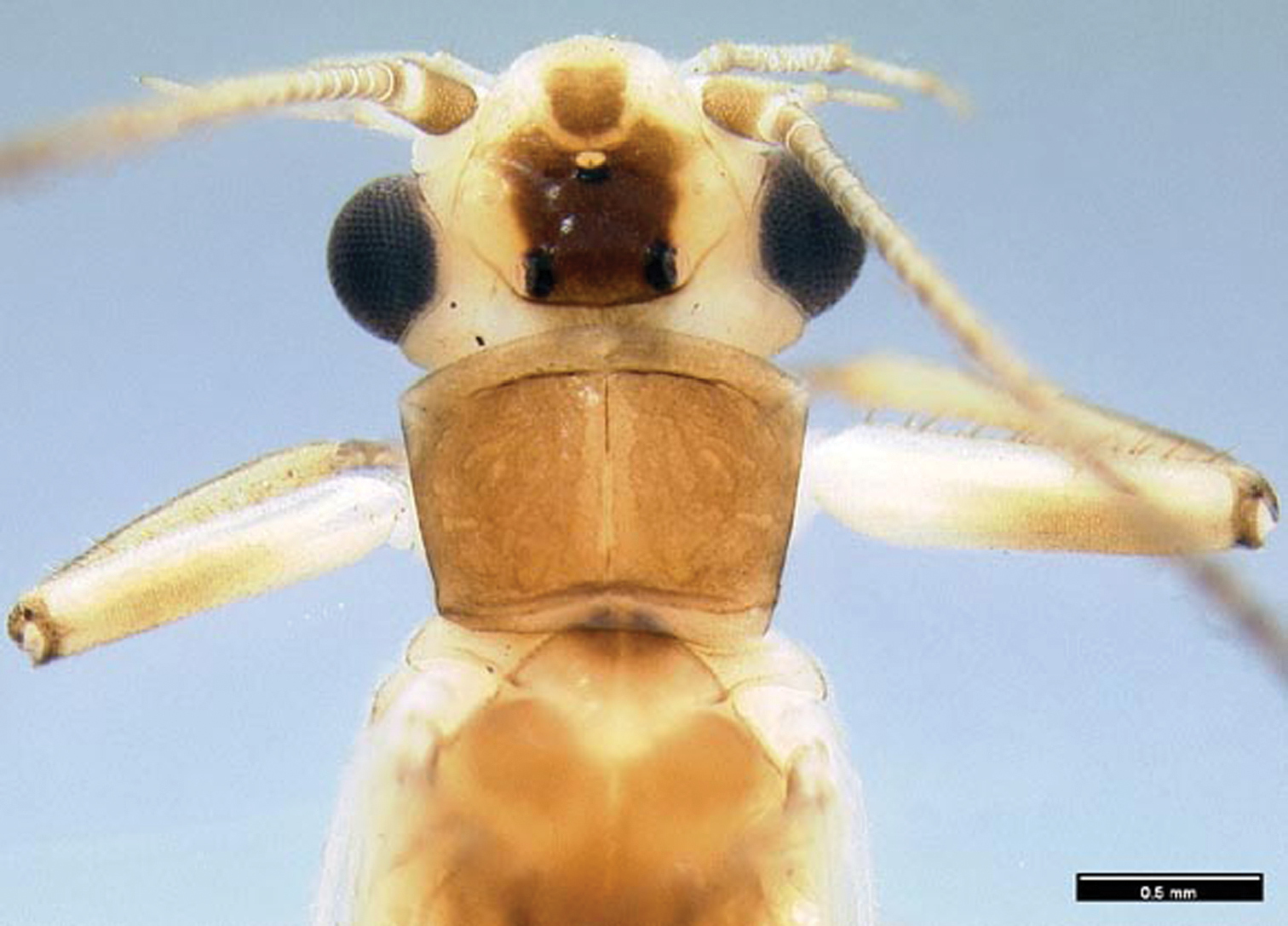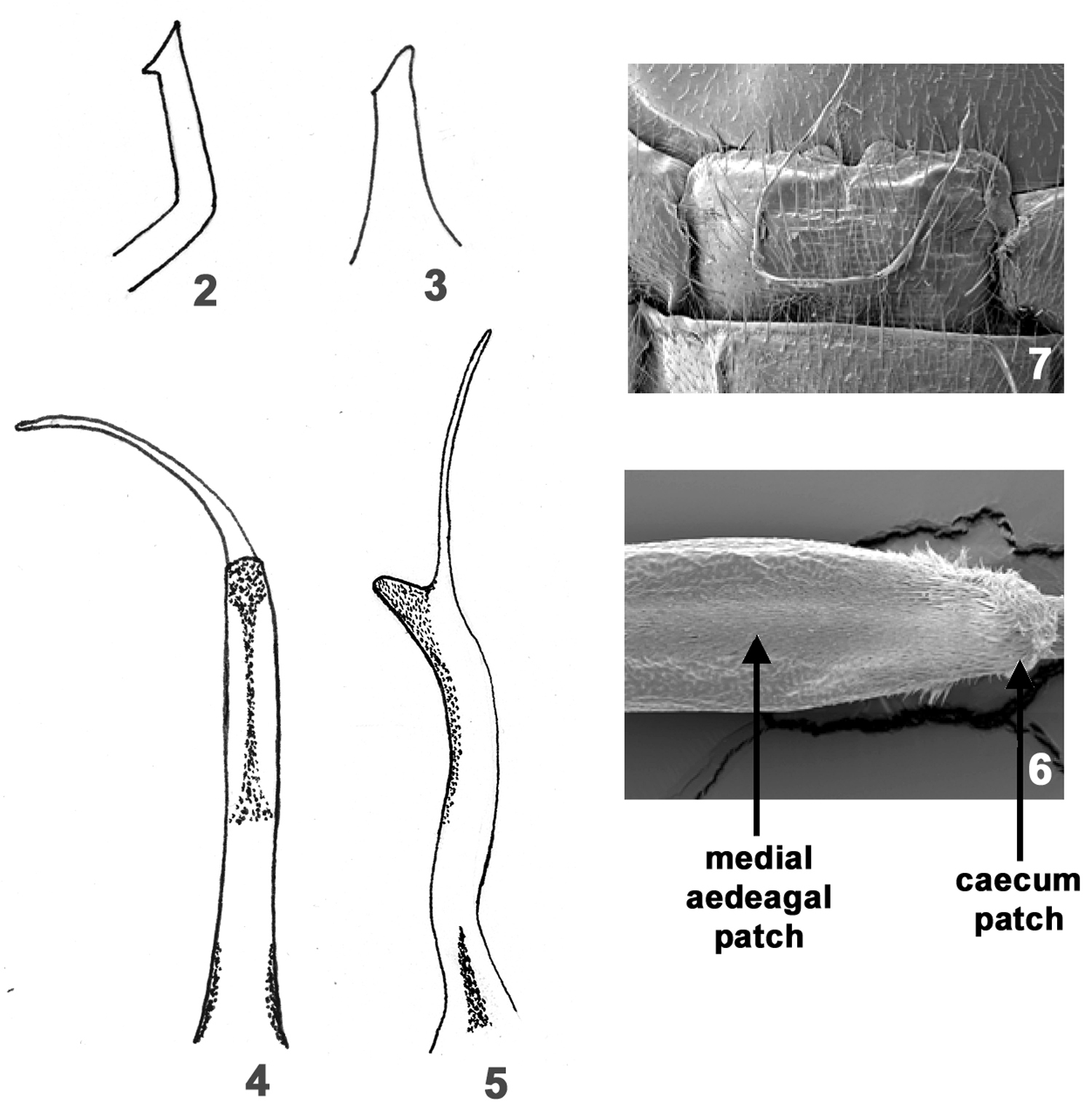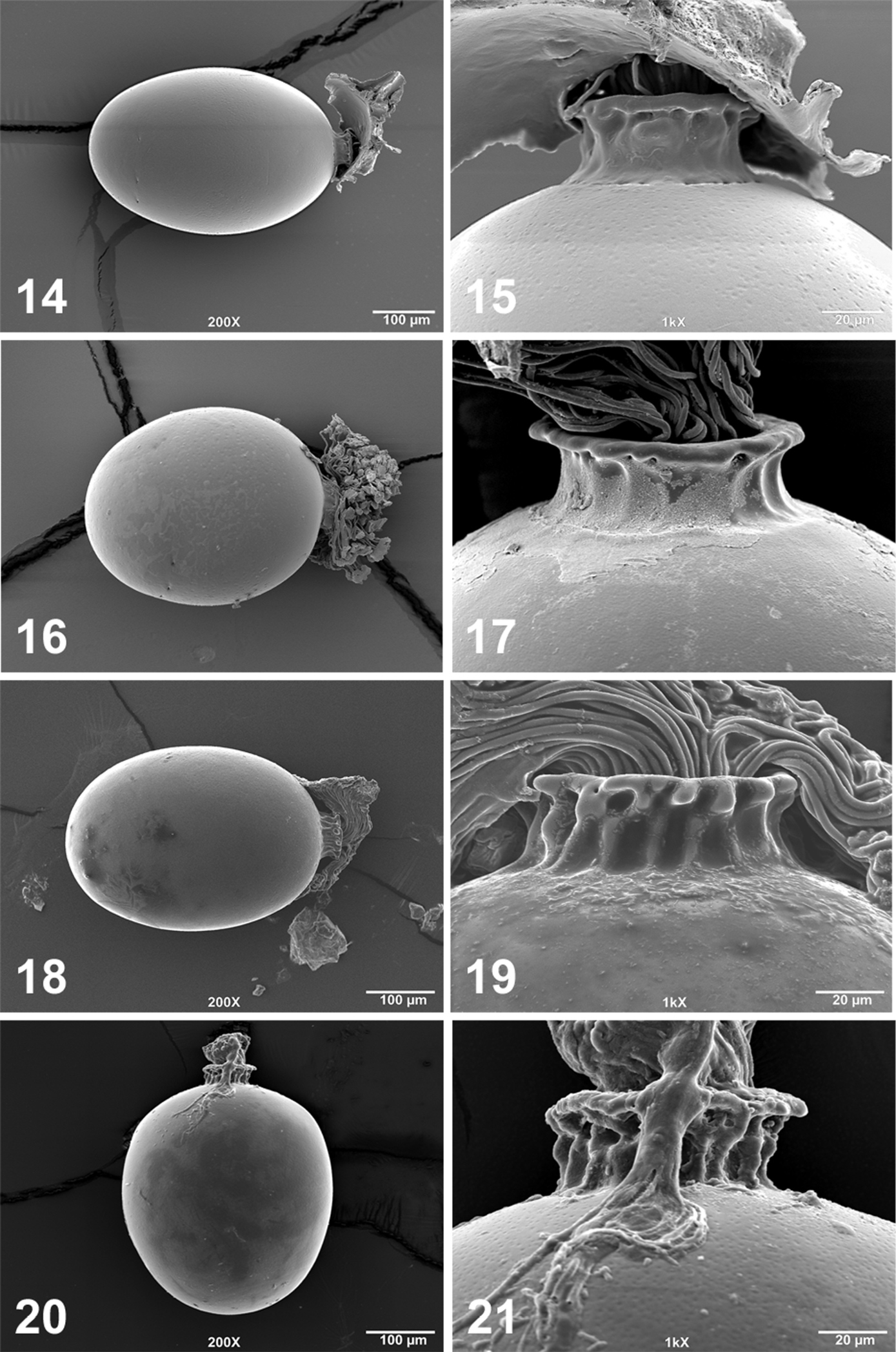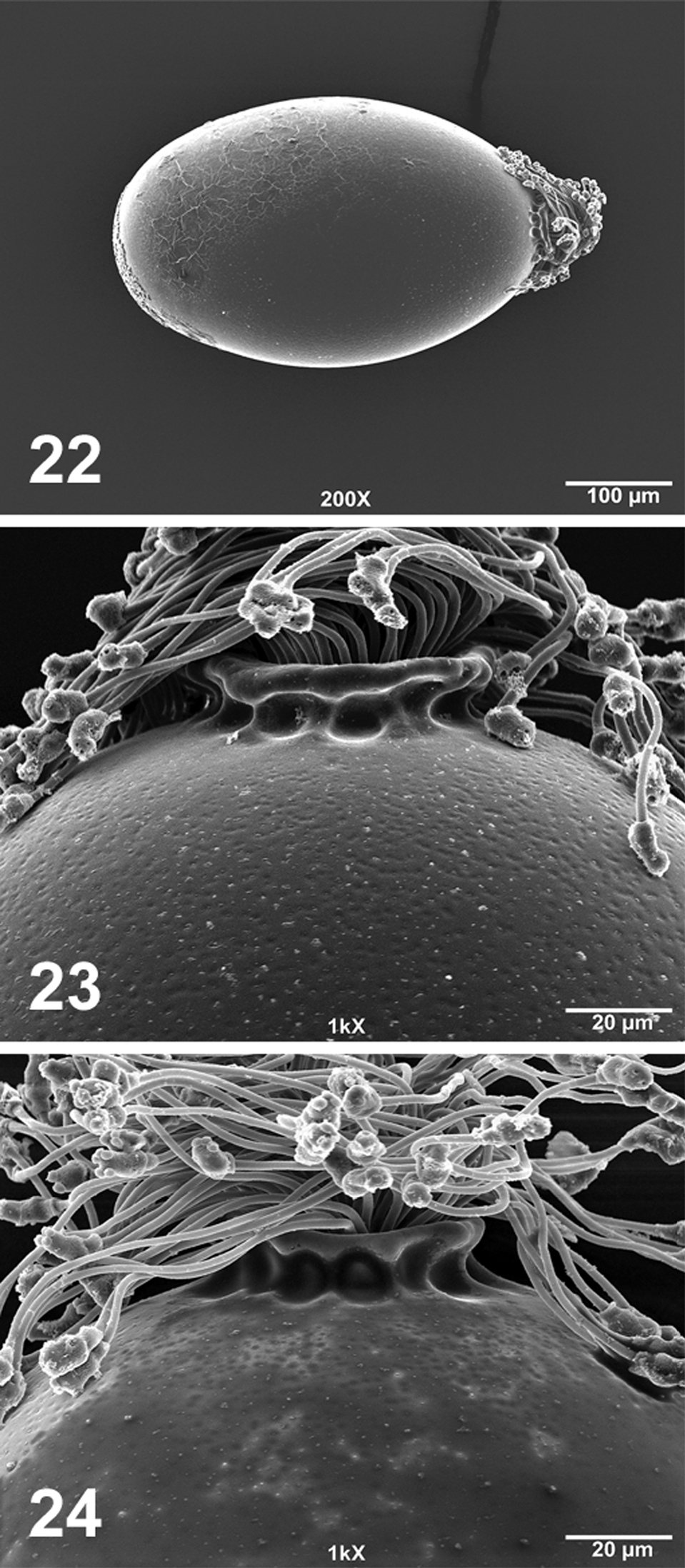






(C) 2012 Scott A. Grubbs. This is an open access article distributed under the terms of the Creative Commons Attribution License 3.0 (CC-BY), which permits unrestricted use, distribution, and reproduction in any medium, provided the original author and source are credited.
For reference, use of the paginated PDF or printed version of this article is recommended.
A new Nearctic species of Perlidae (Insecta, Plecoptera), Perlesta ephelida sp. n., is described from the male, female, and egg stages. This species has been previously reported as, or confused with, Perlesta shubuta Stark from several central and eastern U.S. states. Perlesta ephelida is distinctive from Perlesta shubuta and other regional Nearctic congeners mainly according to male genitalic and egg characteristics. Perlesta ephelida is a widely-distributed eastern Nearctic species, whereas Perlesta shubuta appears to be restricted to a narrow latitudinal belt in the Gulf Coast region from Louisiana east conservatively to the Florida panhandle. The egg of Perlesta shubuta is depicted with scanning electron microscopy for the first time.
Perlesta, Perlidae, Plecoptera, stonefly, new species
Perlesta shubuta Stark (Plecoptera: Perlidae) is a small-bodied, darkly-pigmented stonefly described from southern Mississippi (
The male aedeagus of Perlesta shubuta bears a thumb-shaped caecum, a common feature for the genus (
The type locality for Perlesta shubuta is a sandy-bottom headwater stream. Poulton and Stewart (1991),
Our material that we only tentatively identified as Perlesta shubuta from throughout the central and eastern U.S. has been obtained mainly from larger systems, including low elevation Appalachian Mountain rivers in Alabama, Maryland and West Virginia, and sandy-bottom lowland rivers in Illinois, Indiana and Michigan. Associated nymphs and exuviae obtained through rearings bear a head mask that is freckled to a much greater degree compared to regional congeners. Because of the uncertainty regarding the identity of Perlesta shubuta from localities other than at/near the type locality in southern Mississippi, a comparative study was undertaken to examine available material from across the central and eastern U.S.
Materials and methodsFresh specimens of Perlesta shubuta were obtained from eastern Mississippi and western Alabama in May 2011. A visit to the type locality was unsuccessful. Recently collected material of Perlesta shubuta, in addition to all specimens determined tentatively as Perlesta shubuta, was reexamined with light microscopy to study fine details of the paraprocts, dorsal and lateral aedeagal spinule patterns, and the subgenital plate. Material were obtained from collections from the Bill P. Stark Collection, Mississippi College, Mississippi (BPS), Brigham Young University, Monte L. Bean Museum, Provo, Utah (BYU), Canadian National Collection, Ottawa (CNC), Illinois Natural History Survey, insect collection series, Champaign, Illinois (INHS), Illinois Natural History Survey, Plecoptera catalog series, Champaign, Illinois (INHSPle), A.J. Cook Arthropod Research Collection, Michigan State University, East Lansing, Michigan (MSUC), Ohio Biological Survey, Columbus (OBS), Purdue University Research Collections, West Lafayette, Indiana (PURC), the Royal Ontario Museum, Toronto (ROME), University of Michigan Zoology Collection, Ann Arbor, Michigan (UMMZ), Scott A. Grubbs Collection, Western Kentucky University, Bowling Green, Kentucky (WKU), and University of Wisconsin Entomological Research Center, Madison, Wisconsin (WIRC). All material examined is stored in ethyl alcohol.
Scanning electron micrographs (SEM) of eggs and male dorsal terminalia were prepared from the Alabama and Mississippi samples of Perlesta shubuta. Egg and male SEMs were also prepared for several, tentatively-identified Perlesta shubuta specimens from a broad geographic coverage of the central and eastern U.S.
Taxonomyhttp://species-id.net/wiki/Perlesta_shubuta
Figs 8, 22–24USA: Alabama: Choctaw Co., Bogue Chitto Creek, 20 km NW Butler, 32.1872, -88.3969, 17.v.2011, S.A. Grubbs, ♂, 2♀ (WKU); tributary to Yantley Creek, 13 km NW Cromwell, 32.3004, -88.3837, 17.v.2011, S.A. Grubbs, ♂ (WKU); Sumter Co., Brockway Creek, 8 km SE Ward, 32.3369, -88.1977, 17.v.2011, S.A. Grubbs, ♂, ♀ (WKU). Louisiana: Natchitoches Parish, Kisatchie Bayou, Kisatchie Bayou Campground, Forest Rd. 366, 31.4416, -93.0893, 18.v.1992, at light, R.E. DeWalt, 2♂, ♀ (INHS), same but 9.vi.1992 (reared), R.E. DeWalt, 3♂, ♀ (INHS). Mississippi: Clarke Co., tributary to Long Creek, 20 km E Enterprise, 32.1673, -88.6260, 16.v.2011, S.A. Grubbs, ♂, ♀ (WKU); Rolling Creek, 8 km E Stonewell, 32.1470, -88.7076, 16.v.2011, S.A. Grubbs, 2♂, 2♀ (WKU); Simpson Co., Mill Creek, 14 May 1981, B.P. Stark, ♂ (Paratypes – BPS).
Oblong (Fig. 22). Collar wide but short, highly-infolded, and flanged distally (Figs 23–24). Chorion covered completely by shallow depressions that are visible at higher magnification (1000×; Fig. 23–24).
If the aedeagus is extruded fully, the combination of the updated taxonomic key provided in
urn:lsid:zoobank.org:act:C5983849-EE20-4A42-BEB6-B5588AA1500A
http://species-id.net/wiki/Perlesta_ephelida
Figs 1 –7, 9 –21Holotype: male, in alcohol, USA: Kentucky: Warren Co., Trammel Fork, Drakes Creek, Alvaton, 36.8704, -86.3683, 2.vi.1999, S.A. Grubbs (INHS).
USA: Alabama: Clay Co., Enitachopco Creek, CR 35, 9 km ESE Millersville, 33.1602, -85.8352, 18.v.2008, S.A. Grubbs , 3♂, 2♀ (WKU). Illinois: Winnebago Co., Sugar River, Sugar River Forest Preserve, 42.4604, -89.2399, 22.vi.2010, R.E. DeWalt, E.W. Hernandez and M.M. Brown, 15♂ (INHS-516704). Indiana: Bartholomew Co., East Fork White River, Azalia Bridge, 1.5 km SW Azalia, 39.0849, -85.8598, 11.vi.2000, S.A. Grubbs, 4♂, 3♀ (WKU), same but 9.vii.2008, S.A. Grubbs, ♀ (WKU); Pulaski Co., Tippecanoe River, 8 km NNE Winamac, 41.1316, -86.5880, 28.vi.2006, R.E. DeWalt, 4♂, 3♀ (INHS-164863); Steuben Co., Pigeon River, Rte. 327, 14 km N Helmer, 41.6513, -85.1744, 23.vi.2006, S.A. Grubbs, 3♂, 4♀, 2 nymphs (WKU). Kentucky: Warren Co., same data as Holotype but 24.v.1999, S.A. Grubbs, ♂, 3♀ (WKU), same but 30.v.1999, S.A. Grubbs, ♂ (WKU), same but 19.vi.1999, S.A. Grubbs, ♀ (WKU), same but 20.vi.1999 (reared), S.A. Grubbs, ♀, nymph, exuvia (WKU), same but 22.vi.1999 (reared), S.A. Grubbs, ♀, exuvia (WKU), same but 26.vi.1999, S.A. Grubbs, ♀ (WKU), same but 29.vi.1999, S.A. Grubbs, ♀ (WKU), same but 2.vii.1999, S.A. Grubbs, ♂, ♀ (WKU), same but 9.vii.1999, S.A. Grubbs, ♀ (WKU), same but 20.v.2001, S.A. Grubbs, ♀ (WKU), same but 30.v.2011, S.A. Grubbs, ♂, ♀ (WKU). Maryland: Washington Co., Licking Creek, 1 km N Pectonville, 39.6760, -78.0430, 3.viii.1996, S.A. Grubbs, 7♂ (WKU), same but 6.viii.1996, S.A. Grubbs, ♂ (WKU), same but 12.vii.1997, S.A. Grubbs, 25♂, 69♀ (WKU). Michigan: Calhoun Co., South Branch Kalamazoo River, M-60, Homer, 42.1469, -84.8023, 25.vii.2006, S.A. Grubbs, 6♂, 8♀ (WKU); Ionia Co., Flat River, 2 km N Belding, Flat River State Game Area, 43.1197, -85.2243, 21.vi.2006, S.A. Grubbs, 3♂, 2♀, 4 nymphs (WKU); St. Joseph Co., Rocky River, 1 km SW Moore Park at Floating Bridge Rd., 42.0056, -85.6461, 9.vi.2010, R.E. DeWalt, M. Pessino and E.W. Hernandez, 6♂, 3♀ (INHS-549882). Missouri: Oregon Co., Eleven Point River, Rte.160, Riverton Access, 36.6489, -91, 2004, 27.vi.2011, S.A. Grubbs, 2♂, ♀ (WKU). Ohio: Portage Co., Cuyahoga River, 6 km E Streetsboro Coits Rd., 41.2493, -81.2694, 25.vi.2006, R.E. DeWalt, 11♂, 14♀ (INHS-163781). Wisconsin: Sawyer Co., Namekagon River, NE Hayward, public canoe put-in, 46.0720, -91.4170, 25.vi.2010, R.E. DeWalt, E. Hernandez and M.M. Brown, 5♂, 6♀ (INHS-516414).
CANADA: Flood River, [5 km S Atikokan], 48.7107, -91.5968, ROM Field Party, 3.vii.1984, 4 nymphs (ROM-9496); Ottawa River, Remic Rapids Champlain Bridge, 45.4078, -75.7544, 3.vii.1935, F. P. Ide, 2 nymphs (CNC-1282). USA, Alabama: Calhoun Co., Terrapin Creek, U.S. 278 at CR 33, 4 km NE Piedmont, 33.9550, -85.5712, 17.v.2008, S.A. Grubbs, ♂, ♀ (WKU); Cleburne Co., Tallapoosa River, CR 72, 21 km ENE Heflin, 33.7140, -85.3733, 8.vi.2007, S.A. Grubbs, ♀ (WKU); Talladega Co., Cheaha Creek, CR 005, 12 km NE Talladega, 33.5319, -86.0415, 18.v.2008, S.A. Grubbs, 5♀ (WKU); Talladega Creek, CR 303, 6 km S Talladega, 33.3826, -86.0790, 18.v.2008, S.A. Grubbs, 3♀ (WKU); Tallapoosa Co., Hillabee Creek, 15 km NE Alexander City, 33.0657, -85.8798, 18.v.2008, S.A. Grubbs, ♀ (WKU). Arkansas: Lawrence Co., Spring River, 1 km S Ravenden, 36.2246, -91.2505, 27.vi.2011, S.A. Grubbs, 2♀ (WKU); Sharp Co., Martins Creek, 5 km NE Wilford, 36.2722, -91.3326, 27.vi.2011, S.A. Grubbs, ♂ (WKU). Illinois: Clark Co., Big Creek, 6.5 km NNW Marshall, 39.4480, -87.7170, 21.vi.1993, D.W. Webb, 3♂, 2♀ (INHSPle-2978); Franklin Co., Big Muddy River, Zeigler, 37.8914, -89.0199, 6.viii.1976, S. Herbert, ♂ (INHS-487359). Indiana: Allen Co., Cedar Creek, 1 km W Cedar Canyons at Auburn Rd., 41.2351, -85.1027, 27.vi.2007, R.E. DeWalt, 14♂ (INHS-454376); Cass Co., Eel River, 1 km NE Adamsboro, along CR 600E, 40.7970, -86.2571, 24.v.2006, R.E. DeWalt, ♂, nymph (INHS-164562); Elkhart Co., Little Elkhart River, 5 km E Bristol, Bonnieville Mill County Park, 41.7192, -85.7630, 23.vi.2006, S.A. Grubbs, ♂, 3♀ (WKU); Franklin Co., West Fork Whitewater River, nr. U.S. 52, 1 km W Metamora, 39.4550, -85.1562, 6.vi.2009, S.A. Grubbs, ♀ (WKU); Johnson Co., Sugar Creek, 4.2 km NW Edinburgh, 39.3821, -85.9978, 21.vi.2006, R.E. DeWalt, ♂ (INHS-163722); Kosciusko Co., Cherry Creek, Winona Lake, 41.2270, -85.8220, 30.vi.1947, F, E. Mockford, ♂ (CNC-1288); Monroe Co., Bloomington, 39.1653, -86.5264, 9.vii.1938, Sherrill, ♀ (CNC-1305); Morgan Co., 39.6206, -86.2819, 28.vi.1933, Musgrave, ♀ (PURC-4261); Newton Co., Beaver Lake Ditch, 0.8 km NE Conrad, 41.1073, -87.4373, 8.vii.1998, E. H. Metzler, ♀ (OBS-2910); Starke Co., Kankakee River, 0.25 km N English Lake, 41.2720, -86.8246, 27.vi.2006, R.E. DeWalt, ♀ (INHS-164854); Tippecanoe Co., Wabash River, Lafayette, 40.4202, -86.8971, 16.vii.1923, G. M. Sterrett, ♂ (CNC-1834). Iowa: Buchanon Co., Lime Creek, 3.2 km NE Brandon, 42.3296, -91.9805, 8.vi.2000, D. Heimdal, ♂, ♀ (INHS-36090). Kentucky: Allen Co., Long Creek, Rte. 100, 10 km SE Scottsville, Barren River Lake WMA, 36.6965, -86.0469, 14.vi.2001, S.A. Grubbs and J.M. Taylor, ♂, 15♀ (WKU); Bell Co., Cumberland River, NE of Pineville along US-119, 36.7226, -83.6398, 7.vi.2007, R.E. DeWalt and L. Fennema, 5♂, ♀ ( INHS-454363); Green Co., Little Brush Creek, 5 km WNW Summersville, 37.3344, -85.5913, 3.vi.2006 (reared), S.A. Grubbs, ♂ (WKU); Brush Creek, Rte. 61, 10 km NW Summersville, 37.3909, -85.6105, 3.vi.2006 (reared), S.A. Grubbs, ♀ (WKU); Warren Co., Middle Fork Drakes Creek, 19 km NE Franklin, 36.8187, -86.3944, 10.vi.1999, S.A. Grubbs, ♂, ♀ (WKU); at confluence of Barren River and Green River, 15 km NW Richardsville, 37.1809, -86.6232, 4.vi.1999, S.A. Grubbs, ♂ (WKU); Maryland: Allegany Co., Flintstone Creek, Flintstone, 14.viii.1995, 39.7079, -78.5664, S. A. Grubbs, ♀ (WKU), same but 4.vii.1996, S.A. Grubbs, 9♂, 4♀ (WKU), same but 2.viii.1996, S. A. Grubbs, ♂, 3♀ (WKU); Sideling Hill Creek, Scenic U.S. 40, nr. Bellegrove, 39.7044, -78.3284, 3.viii.1996, S.A. Grubbs, 7♀ (WKU), same but 23.vi.1997, S.A. Grubbs, 3♀ (WKU), same but 14.vii.1998, S.A. Grubbs, 3♂ (WKU); Sideling Hill Creek, 1 km NE Bellegrove, 39.7084, -78.3313, 4.vii.1996, S.A. Grubbs, ♂, 6♀ (WKU); Town Creek, 5 km NE Oldtown, Green Ridge State Forest, 39.5744, -78.5468, 4.vii.1996, S.A. Grubbs, 2♂, 10♀ (WKU), same but 8.vi.1998, S.A. Grubbs, 3♂, 2♀ (WKU); Harford Co., Deer Creek, 7 mi NW Bel Air, Rocks State Park, 39.6314, -76.4052, 12.vii.1998, S.A. Grubbs, ♂, 2♀ (WKU); Washington Co., Conococheague Creek, 1 km E Fairview, 39.7163, -77.8256, 14.vii.1998, S.A. Grubbs, 10♂, 24♀ (WKU); Tonoloway Creek, Hancock, 39.6981, -78.1565, 3.viii.1996, S.A. Grubbs, 2♀ (WKU). Massachusetts: Hampshire Co., Ware River, Rte. 32, 3 km S Gilbertsville, 42.2847, -72.2161, 28.vi.2006, S.A. Grubbs, ♂ (WKU). Michigan: Allegan Co., Rabbit River, 10 km W Wayland, 42.6779, -85.7612, 19.vi.2006, S.A. Grubbs, ♂, ♀ (WKU); Benzie Co., [Platte River], Benzie State Park, 44.7183, -86.1165, 23.viii.1960, R.A. Scheibner, ♀ (MSUC-8317); Berrien Co., Dowagiac Creek, U.S. 31, Niles, 41.8452, -86.2621, 30.vii.1994, S.A. Grubbs, 5♂, 4♀, 2 nymphs (WKU), same but 7.vi.2001, S.A. Grubbs, 4♂, 2♀ (WKU); Dowagiac Creek, M-51, 2 km N Niles, 41.8643, -86.2416, 19.vi.2006, S.A. Grubbs, 8♂, 9♀ (WKU); Galien River, New Buffalo, 41.8084, -86.7154, 22.vi.1957, J. Lowe, 2♂, ♀ (CNC-500); Clare Co., Middle Branch Tobacco River, 11 km NE Clare, 43.9092, -84.7006, 24.vii.2006, S.A. Grubbs, ♂, 2 nymphs, exuviae (WKU); Clinton Co., Vermillion Creek, Bath, 42.8345, -84.3692, 15.vii.1955, R.L. Fischer, ♂ (MSUC-7832); Gladwin Co., Cedar River, 5 km N Beaverton, 43.9308, -84.4760, 24.vii.2006, S.A. Grubbs, ♀ (WKU); Hillsdale Co., East Branch St. Joseph River, 14 km W Hudson, Lost Nation State Game Area, 41.8635, -84.5145, 23.vi.2006, S.A. Grubbs, ♂, ♀ (WKU); East Fork West Branch St Joseph River, 14 km S Hillsdale at Dimmers Road, 41.7960, -84.6380, 27.vii.2000, J. Mandrelle, 5♂, 11♀ (OBS-6338); West Branch St. Joseph River, Boy Scout Camp Property, 5 km E State Rte. 49 at Territorial Road, 41.7071, -84.6903, 27.vi.2000, J. Mandrelle, ♂, 7♀ (OBS-6324); Ingham Co., [Grand River], Lansing, 42.7325, -84.5497, 23.vi.1981, ♂ (MSUC-2368); Isabella Co., Pine River, 8 km N Cedar Lake, Edmond State Game Area, 43.4733, -84.9701, 21.vi.2006, S.A. Grubbs, 3♀ (WKU); Kalamazoo Co., Kalamazoo River, 1.5 km SW Galesburg at 35th St., 42.2803, -85.4285, 19.vi.2010, R.E. DeWalt, M. Pessino and E.W. Hernandez, 3♂, ♀ (INHS-550553); Lake Co., Pere Marquette River, 7 km E Baldwin, 43.8869, -85.9370, 23.vii.2006, S.A. Grubbs, 2♂ (WKU); Lenawee Co., River Raisin, 10 km NE Adrian, 41.9492, -83.9415, 23.vi.2006, S.A. Grubbs, ♂ (WKU); [River Raisin], Clinton, 42.0718, -83.9796, 28.vi.1941, T.H. Frison and H.H. Ross, ♂ (INHSPle-3828); Livingston Co., Portage River, 3 km SE Hell at Dexter-Town Hall Rd, 42.4242, -83.9497, 9.vi.2010, R.E. DeWalt, M. Pessino and E.W. Hernandez, 12♂, 12♀ (INHS-514942); Menominee Co., Little Cedar River, 6 km W Carney at G18, 45.5799, -87.6332, 9.vii.2011, R.E. DeWalt, 2♀ (INHS-552590); Montcalm Co., Fish Creek, Carson City, 43.1773, -84.8566, 21.vi.2006, S.A. Grubbs, 3♂ (WKU); Flat River, Greenville, 43.1771, -85.2478, 21.vi.2006, S.A. Grubbs, ♂ (WKU); Flat River, at Hunter Lake, T11N R8W Sec. 33, 43.2921, -85.2592, 8.vii.1966, J. P. Donahue, 3♀ (MSUC-7480); Presque Isle Co., 45.3077, -83.8724, 5.viii.1948, ♂ (MSUC-7839); Saginaw Co., Bad River, 10 km W St. Charles, 43.2987, -84.2689, 21.vi.2006, S.A. Grubbs, ♂ (WKU); St. Clair Co., Bad River, 15 km SE Yale, 43.0926, -82.6181, 22.vi.2006, S.A. Grubbs, 3♂, 2♀ (WKU); St. Joseph Co., Pigeon River, 7 km WSW Pigeon River, 41.7764, -85.7213, 19.vi.2006, S.A. Grubbs, 3♂, ♀ (WKU), same but 21.vii.2006, S.A. Grubbs, ♂, ♀ (WKU); Portage River, Parkville, 42.0146, -85.5480, 19.vi.2006, S.A. Grubbs, ♂, 2♀ (WKU); Prairie River, Centreville, 41.9291, -85.5284, 21.vii.2006, S.A. Grubbs, ♀ (WKU); Washtenaw Co., Huron River 3 km SE Dexter, 42.3283, -83.8531, 22.vi.2006, S.A. Grubbs, 2♂, ♀ (WKU); Huron River, Scio township, 42.3235, -83.8404, 20.vi.1988, T.E. Moore, ♂, ♀ (UMMZ-2807). Missouri: St. Francois Co., Big River, Adjacent to picnic grounds, 37.9669, -90.5346, 19.vi.2008, R.E. DeWalt, ♂ (INHS-515558). Ohio: Ashland Co., Clear Fork [Mohican] River, SE Pleasant Hill Reservoir, 40.6082, -82.2540, ♀, T. Yamamoto, L. Kohalmi, 1.viii.1968, ROME-9773); Ashtabula Co., Ashtabula River, 1.9 km WNW Gageville, 41.8486, -80.6895, 15.vii.1998, M. Silvaggio, 5♀ (OBS-3047); Columbiana Co., Little Beaver Creek, Wayne Twp. [at Steubenville Rd], 40.6947, -80.7658, 14.vii.1997, E.G. Chapman, 2♀ (OBS-6653); Coshocton Co., Bucklew Run, 5 km E Warsaw at Twp. 28 Rd., 40.3323, -81.9378, 26.vi.1999, S.W. Chordas III and J. Thompson, 5♂, 2♀ (OBS-3212); Defiance Co., Mud Creek, 13 km WNW Defiance, 41.3339, -84.4968, 17.vii.2000, S.W. Chordas III and E.G. Chapman, ♀ (OBS-6372); Lake Co., Paine Creek, SE Lane, 41.7208, -81.1761, 22.vi.1999, ♀ (INHS-163045); Licking Co., North Fork Licking River, 3 km S Utica, 40.2095, -82.4428, 13.vii.1999, S. O’Dee, ♀ (OBS-2904); Miami Co., Rush Creek, 5 km NE Piqua, 40.1821, -84.2151, 17.vii.2000, S.W. Chordas III and E.G. Chapman, ♀ (OBS-3064); Paulding Co., Maumee River, 16 km NW Paulding, 41.1983, -84.7467, 17.vii.2000, S.W. Chordas III and E.G. Chapman, ♂, ♀ (OBS-6330); Pike Co., Pike State Forest, 39.1031, -83.2682, 1.vi.1938, C.R. Neiswander, 2♂, ♀ (INHSPle-3907); Richland Co., Rocky Fork Mohican River , SE Mansfield, 40.7025, -82.3666, 27.vii.1999, E.G. Chapman, 2♀ (OBS-6313); Scioto Co., 38.8371, -83.0445, 1.vi.1925, C.H. Kennedy, ♂ (OSU-10765); Vinton Co., Pike Run, at SR 327 deadend, 39.3074, -82.7315, 7.vii.1996, J. McCreery, ♀ (OBS-7229); Wayne Co., Killbuck Creek, 9 km SW Wooster, 40.6945, -81.9798, 22.vi.1999, E.G. Chapman, 8♀ (OBS-6327); Williams Co., East Branch St. Joseph River, 4 km N Pioneer, 41.6950, -84.5107, 27.vii.2000, J. Mandrelle, 3♀ (OBS-6339). West Virginia: Morgan Co., Cacapon River, Rte. 9, 39.5286, -78.3478, 12.vi.1998, S.A. Grubbs, 3♂, 3♀ (WKU). Wisconsin: Burnett Co., St. Croix River, Riverside, 46.0772, -92.2461, 25.vi.2010, R.E. DeWalt, E. Hernandez and M.M. Brown, 2♂, 3♀ (INHS-516406); Dane Co., 43.0186, -89.5498, 30.vi.1949, W. McNeel, ♀ (WIRC-7152); Fond Du Lac Co., T13N, R19E, S23, 43.6687, -88.1938, 24.vi.1975, ♀ (WIRC-14414); Jackson Co., Halls Creek, , 44.3594, -90.7845, 18.vi.1968, ♀ (WIRC-14729); Lincoln Co., Prairie River, WI-17, 45.3361, -89.4650, 20.viii.1992, R.W. Baumann and C.R. Nelson, ♂, ♀ (BYU-1); Marinette Co., Menominee River, 18 km NE Amberg at CR-Z, 45.5814, -87.7866, 26.vi. 2010, R.E. DeWalt, E. Hernandez and M.M. Brown, 10♂ (INHS-550141); Price Co., [South] Fork Flambeau River, Fifield, 45.8798, -90.4156, 18.vi.1934, T.H. Frison and C.O. Mohr, ♂ (INHSPle-3908); Vilas Co., Trout River, Trout Lake , 46.0350, -89.7059, 22.vii.1937, T.H. Frison and H.H. Ross, ♂ (INHSPle-3811).
Perlesta ephelida. 1. Adult head and pronotum, dorsal.
Perlesta ephelida. 2 Left paraproct, lateral 3 Left paraproct, caudal 4 Aedeagus, dorsal 5 Aedeagus, lateral 6 SEM micrograph, aedeagus, dorsal, 500X 7 SEM micrograph, female terminalia, ventral, 150X.
Male terminalia, posterodorsal view, SEM micrographs (8 Perlesta shubuta, USA, Mississippi, Clarke Co., Rolling Creek, 16 May 2011, 500X 9–13 Perlesta ephelida 9 USA, Alabama, Clay Co., Enitachopco Creek, 18 May 2008, 350X 10 USA, Indiana, Bartholomew Co., East Fork White River, 11 June 2000, 350X 11 USA, Maryland, Washington Co., Licking Creek, 12 July 1997, 350X 12 USA, Michigan, Calhoun Co., South Branch Kalamazoo River, 25 July 2006, 350X 13 USA, Missouri, Oregon Co., Eleven Point River, 27 June 2011, 200X.
Perlesta ephelida egg SEM micrographs (14–15 USA, Kentucky, Warren Co., Trammel Fork, Drakes Creek, 24 May 1999 16–17 USA, Maryland, Washington Co., Licking Creek, 12 July 1997 18–19 USA, Michigan, Calhoun Co., South Branch Kalamazoo River, 25 July 2006 20–21 USA, Arkansas, Lawrence Co., Spring River, 27 June 2011) 14, 16, 18, 20 Entire egg, 200X; 15, 17, 19, 21. Anterior pole and collar, 1000X.
Head yellow with a dark brown subquadrate ocellar patch and a small, light brown subtriangular patch anterior to the anterior ocellus, pronotum golden-brown with a very faint lighter medial stripe in some specimens (Fig. 1). Wing membrane and veins amber except for pale costal region. Femora dorsally brown, laterally and ventrally yellow; tibia brown. Abdominal terga and sterna yellow. Cerci pale yellow proximally, brown distally.
Forewing length 7.5–8.5 mm. Tergum 10 mesal sclerites brown, sensilla basiconica patch distinct with interspersed long hairs (Figs 9–13). Paraproct broadest basally, apically acute, with distinct subapical tooth directed anteromedially (Fig. 2) and typically seen dorsally (Figs 9–13), in caudal view resembling a hypotenuse triangle and tooth visible (Fig. 3). Penis tube + sac long, caecum moderately-sized and thumb-shaped (Fig. 4), lateral sclerite distinct, dorsal patch broad basally, narrowing to narrow strip before expanding apically over caecum and tube (Fig. 5). At higher magnification the dorsal aedeagal patch hairs are noticeably shorter than the expanded portion over the caecum (Fig. 6).
Forewing length 9.0–11.0 mm. Subgenital plate lobes comprise medial half of 7th sternite, extending scarcely past anterior margin of 8th sternite, outer margins rounded, inner margins rounded and expanded slightly distally, separated by a shallow v-shaped notch (Fig. 7).
Oval. Collar wide and distinctly stalked, highly-infolded, and flanged distally. Chorion smooth or finely pitted (Figs 14–21). Micropyles located ca. ¼ from posterior pole.
Undescribed.
The species name is a derivation of the Greek word (“ephelis”) for freckle (
The males of Perlesta ephelida will key to couplets 11 and 12 in
Perlesta shubuta egg SEM micrographs (22–23 USA, Mississippi, Clarke Co., Rolling Creek, 16 May 2011 23 USA, Alabama, Choctaw Co., Bogue Chitto Creek, 17 May 2011) 22 Entire egg, 200X 23–24 Anterior pole and collar, 1000X.
The type locality is a 5th-order gravel-bottom stream positioned in the Western Pennyroyal Karst Plain Level IV Ecoregion. Additional stonefly species obtained from the type locality were Allocapnia granulata (Claassen, 1924), Allocapnia nivicola (Fitch, 1847), Allocapnia recta (Claassen, 1924), Allocapnia rickeri Frison, 1929, Amphinemura alabama Baumann, 1996, Allocapnia nigritta (Provancher, 1876), Strophopteryx fasciata (Burmeister, 1839), Taeniopteryx maura (Pictet, 1841), Acroneuria frisoni Stark & Brown, 1991, Perlinella drymo (Newman, 1839), Perlesta ephyre (Newman, 1839), Neoperla catharae Stark & Baumann, 1978, Neoperla stewarti Stark & Baumann, 1978, Clioperla clio (Newman, 1839), Isoperla decepta Frison, 1935, and Pteronarcys dorsata (Say, 1823).
Perlesta ephelida is distributed broadly across the central and eastern U.S. from eastern Alabama northeast to Massachusetts, north to the Great Lakes region and Iowa, and northwest to the Interior Highlands region of Arkansas, Missouri, and Oklahoma. Perlesta ephelida is expected to be collected from intervening states (e.g. Pennsylvania, Tennessee) where this species has yet to be reported. In contrast, Perlesta shubuta appears to be restricted to a narrow latitudinal belt in the Gulf Coast region of the southeastern U.S., known currently from Louisiana east to northern Florida panhandle and likely to South Carolina.
The Perlesta shubuta records reported from Illinois (
| 11 | Dorsal aedeagal patch covers about 1/3 of tube surface length ( |
Perlesta shubuta Stark |
| – | Dorsal aedeagal patch covers most of tube surface length ( |
12 |
| 12 | Paraproct spine directed mesad, visible in caudal aspect ( |
12a |
| – | Paraproct spine directed forward, not visible in caudal aspect ( |
Perlesta decipiens (Walsh) |
| 12a | Dorsal aedeagal patch narrower | Perlesta puttmanni Kondratieff & Kirchner |
| – | Dorsal aedeagal patch wider | Perlesta ephelida Grubbs & DeWalt, sp. n. |
We thank the following individuals for loan of specimens for this project: Bill P. Stark (BPS), Richard W. Baumann and Shawn Clark (BYU), Ian Smith (CNC), Gary Parsons (MSUC), Brian Armitage (OBS), Norman Johnson (OSU), Arwin Provonsha (PURC), Antonia Guidotti(ROME), Mark F. O’Brien (UMMZ), and Steven Krauth (WIRC). Funding to support this research has been provided by Western Kentucky University Faculty Scholarship Grants and Summer Fellowships to SAG, a United States of America National Science Foundation DEB 09-18805 ARRA award to the authors, and a United States Department of Interior grant X-1-R-1 to RED.




